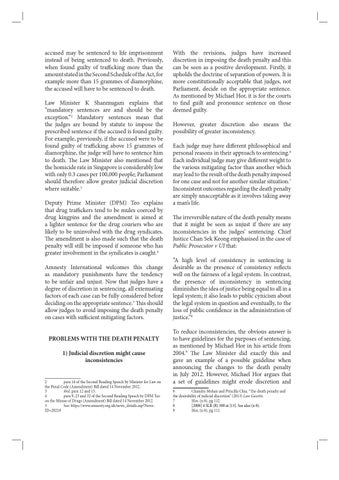accused may be sentenced to life imprisonment instead of being sentenced to death. Previously, when found guilty of trafficking more than the amount stated in the Second Schedule of the Act, for example more than 15 grammes of diamorphine, the accused will have to be sentenced to death. Law Minister K Shanmugam explains that “mandatory sentences are and should be the exception.”2 Mandatory sentences mean that the judges are bound by statute to impose the prescribed sentence if the accused is found guilty. For example, previously, if the accused were to be found guilty of trafficking above 15 grammes of diamorphine, the judge will have to sentence him to death. The Law Minister also mentioned that the homicide rate in Singapore is considerably low with only 0.3 cases per 100,000 people; Parliament should therefore allow greater judicial discretion where suitable.3 Deputy Prime Minister (DPM) Teo explains that drug traffickers tend to be mules coerced by drug kingpins and the amendment is aimed at a lighter sentence for the drug couriers who are likely to be uninvolved with the drug syndicates. The amendment is also made such that the death penalty will still be imposed if someone who has greater involvement in the syndicates is caught.4 Amnesty International welcomes this change as mandatory punishments have the tendency to be unfair and unjust. Now that judges have a degree of discretion in sentencing, all extenuating factors of each case can be fully considered before deciding on the appropriate sentence.5 This should allow judges to avoid imposing the death penalty on cases with sufficient mitigating factors. PROBLEMS WITH THE DEATH PENALTY 1) Judicial discretion might cause inconsistencies
2 para 14 of the Second Reading Speech by Minister for Law on the Penal Code (Amendment) Bill dated 14 November 2012. 3 ibid, para 12 and 13. 4 para 9, 23 and 32 of the Second Reading Speech by DPM Teo on the Misuse of Drugs (Amendment) Bill dated 14 November 2012. 5 See: https://www.amnesty.org.uk/news_details.asp?NewsID=20218
With the revisions, judges have increased discretion in imposing the death penalty and this can be seen as a positive development. Firstly, it upholds the doctrine of separation of powers. It is more constitutionally acceptable that judges, not Parliament, decide on the appropriate sentence. As mentioned by Michael Hor, it is for the courts to find guilt and pronounce sentence on those deemed guilty. However, greater discretion also means the possibility of greater inconsistency. Each judge may have different philosophical and personal reasons in their approach to sentencing.6 Each individual judge may give different weight to the various mitigating factor than another which may lead to the result of the death penalty imposed for one case and not for another similar situation.7 Inconsistent outcomes regarding the death penalty are simply unacceptable as it involves taking away a man’s life. The irreversible nature of the death penalty means that it might be seen as unjust if there are any inconsistencies in the judges’ sentencing. Chief Justice Chan Sek Keong emphasised in the case of Public Prosecutor v UI that: “A high level of consistency in sentencing is desirable as the presence of consistency reflects well on the fairness of a legal system. In contrast, the presence of inconsistency in sentencing diminishes the idea of justice being equal to all in a legal system; it also leads to public cynicism about the legal system in question and eventually, to the loss of public confidence in the administration of justice.”8 To reduce inconsistencies, the obvious answer is to have guidelines for the purposes of sentencing, as mentioned by Michael Hor in his article from 2004.9 The Law Minister did exactly this and gave an example of a possible guideline when announcing the changes to the death penalty in July 2012. However, Michael Hor argues that a set of guidelines might erode discretion and 6 Chandra Mohan and Priscilla Chia, “The death penalty and the desirability of judicial discretion” (2013) Law Gazette. 7 Hor, (n 6), pg 112. 8 [2008] 4 SLR (R) 500 at [15]. See also (n 8). 9 Hor, (n 6), pg 111.
